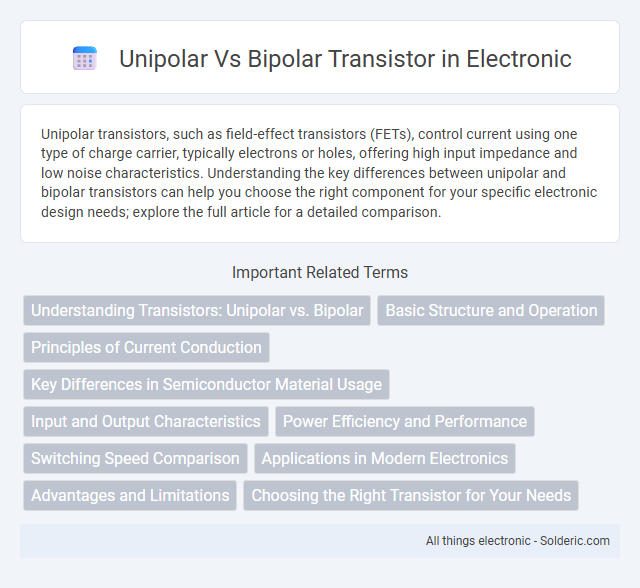Unipolar transistors, such as field-effect transistors (FETs), control current using one type of charge carrier, typically electrons or holes, offering high input impedance and low noise characteristics. Understanding the key differences between unipolar and bipolar transistors can help you choose the right component for your specific electronic design needs; explore the full article for a detailed comparison.
Comparison Table
| Feature | Unipolar Transistor (FET) | Bipolar Transistor (BJT) |
|---|---|---|
| Charge Carriers | Single type (electrons or holes) | Both electrons and holes |
| Control Mechanism | Voltage-controlled | Current-controlled |
| Input Impedance | High (Megaohms to Gigaohms) | Low (Kiloohms) |
| Switching Speed | Generally faster | Relatively slower |
| Noise Level | Low noise | Higher noise |
| Power Consumption | Lower | Higher |
| Applications | Amplifiers, switches, digital circuits | Amplifiers, analog circuits, switching |
| Example | MOSFET, JFET | NPN, PNP transistors |
Understanding Transistors: Unipolar vs. Bipolar
Unipolar transistors, such as MOSFETs, operate using a single type of charge carrier--either electrons or holes--resulting in high input impedance and fast switching speeds ideal for digital circuits. Bipolar transistors, including BJTs, rely on both electrons and holes, enabling higher current density and gain, making them suitable for analog amplification. Understanding the charge transport mechanisms and input characteristics is essential for selecting the appropriate transistor type in electronic circuit design.
Basic Structure and Operation
Unipolar transistors, such as MOSFETs, rely on a single type of charge carrier (electrons or holes) for current conduction, featuring a three-terminal structure with a gate controlling the flow between source and drain. Bipolar transistors (BJTs) use both electrons and holes as charge carriers, consisting of three layers (emitter, base, and collector) where current flow is controlled through the base-emitter junction. The operation of unipolar transistors is governed by the electric field effect on a semiconductor channel, while bipolar transistors operate based on the injection and recombination of charge carriers within the transistor layers.
Principles of Current Conduction
Unipolar transistors, such as Field Effect Transistors (FETs), conduct current primarily through the movement of majority carriers, either electrons or holes, controlled by an electric field. Bipolar transistors rely on both majority and minority carriers for current conduction, utilizing the injection and recombination of electrons and holes across the base-emitter junction. Your choice between unipolar and bipolar transistors impacts switching speed, gain, and input impedance due to these inherent conduction principles.
Key Differences in Semiconductor Material Usage
Unipolar transistors, such as field-effect transistors (FETs), primarily utilize a single type of charge carrier--electrons or holes--within semiconductor materials like silicon or gallium arsenide. Bipolar transistors, including bipolar junction transistors (BJTs), depend on both electrons and holes, requiring complex layering of n-type and p-type semiconductor materials to form emitter, base, and collector regions. This fundamental difference in semiconductor material usage influences their electrical characteristics, switching speeds, and application suitability.
Input and Output Characteristics
Unipolar transistors, such as MOSFETs, exhibit high input impedance due to their voltage-controlled gate, resulting in minimal input current and efficient signal control. Bipolar junction transistors (BJTs) have lower input impedance with current-controlled input, where the base current modulates the collector current, affecting their input-output relationship. Your choice between unipolar and bipolar transistors depends on the desired input impedance and switching speed in your electronic circuit design.
Power Efficiency and Performance
Unipolar transistors, such as MOSFETs, offer higher power efficiency due to their majority carrier conduction, resulting in lower on-state resistance and reduced power loss. Bipolar transistors (BJTs) provide superior performance in linear amplification with higher current gain but suffer from greater power dissipation because of minority carrier injection. MOSFETs dominate power electronics where efficiency is critical, while BJTs are preferred in applications requiring high gain and fast switching response.
Switching Speed Comparison
Unipolar transistors, such as MOSFETs, generally exhibit faster switching speeds compared to bipolar junction transistors (BJTs) due to their majority carrier operation which minimizes charge storage effects. The absence of minority carrier recombination in unipolar devices reduces delay times, making MOSFETs preferable in high-frequency and high-speed applications. Bipolar transistors, while offering higher gain, often experience slower switching due to charge storage in the base region, impacting overall switching performance.
Applications in Modern Electronics
Unipolar transistors, such as MOSFETs, dominate in digital circuits and power management applications due to their high switching speed and low power consumption. Bipolar transistors excel in analog amplification and radio-frequency (RF) applications because of their superior current handling and linearity. Modern electronics leverage unipolar transistors for microprocessors and memory devices, while bipolar transistors remain critical in audio amplifiers and RF transmitters.
Advantages and Limitations
Unipolar transistors, such as MOSFETs, offer high input impedance, fast switching speed, and low power consumption, making them ideal for digital circuits and low-voltage applications. Bipolar transistors provide high current density and gain, which enhances linear amplification and drive capabilities but suffer from higher power dissipation and slower switching compared to unipolar devices. Understanding these advantages and limitations helps you select the appropriate transistor type for your specific electronic design requirements.
Choosing the Right Transistor for Your Needs
Choosing the right transistor depends on your circuit requirements and signal frequency. Unipolar transistors, such as MOSFETs, are preferred for high-speed switching and low power consumption applications, offering high input impedance and fast response times. Bipolar junction transistors (BJTs) excel in analog signal amplification where linearity and gain are critical, making them suitable for audio and RF circuits in your designs.
Unipolar vs Bipolar transistor Infographic

 solderic.com
solderic.com